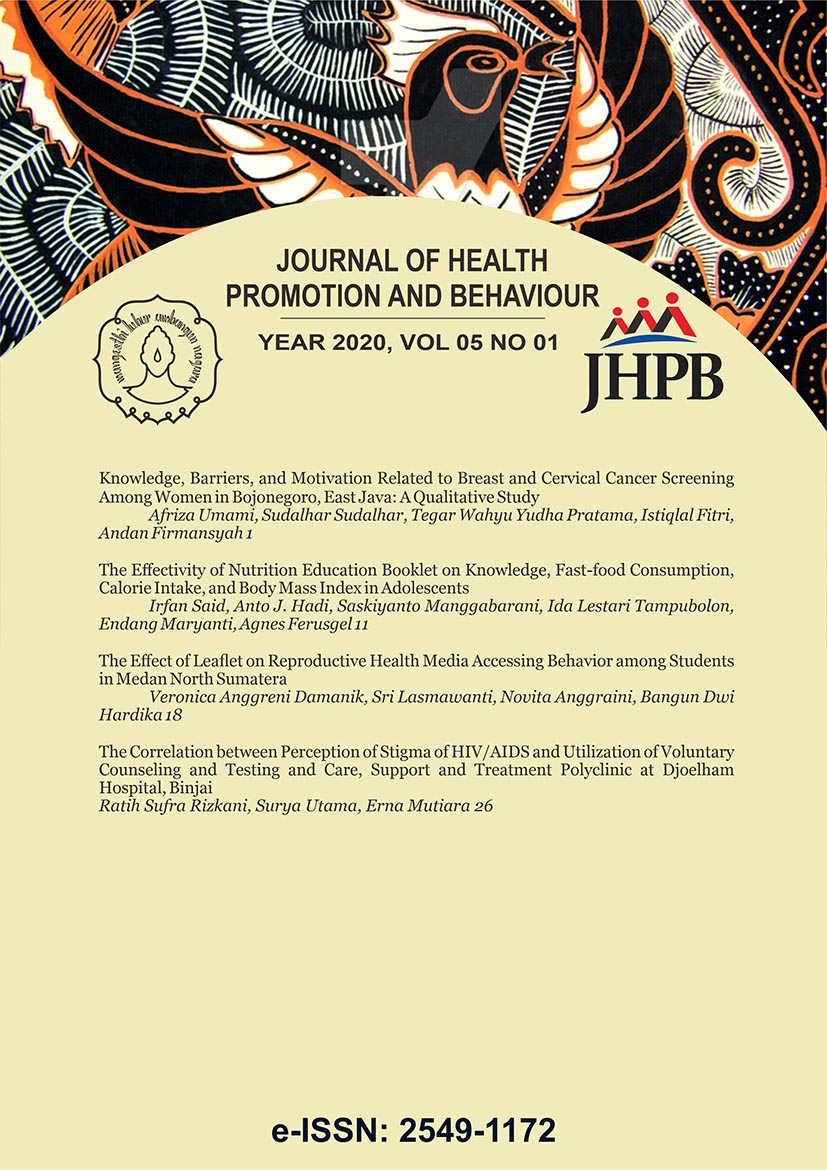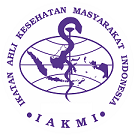The Effectivity of Nutrition Education Booklet on Knowledge, Fast-food Consumption, Calorie Intake, and Body Mass Index in Adolescents
Abstract
Background: The prevalence of adolescent obesity is increasing worldwide with proportions varying from country to country or between geographical regions within a country. The purpose of this study was to determine the effect of nutrition education with booklet media on knowledge, fast food consumption, calorie intake, and body mass index (BMI) in adolescents.
Subjects and Method: This was a quasy experiment with no control group. The study was conducted in Junior high school in Medan, North Sumatera. A sample of 31 adolescents was selected by purposive sampling. The dependent variables were knowledge, fast-food consumption, calorie intake, and BMI. The independent variables were booklet media. Means of knowledge, fast food consumption, calorie intake, and BMI before and after intervention was examined by t-test.
Results: Mean of knowledge after intervention (Mean= 12.90; SD= 2.71) was higher than before (Mean= 8.77; SD= 1.54) and it was statisticaly significant (p<0.001). Mean of fast food consumption after intervention (Mean= 9.48; SD= 1.38) was lower than before (Mean= 10.03; SD= 1.16) and it was statistically significant (p= 0.007). Mean of calorie intake after intervention (Mean= 2735.12; SD= 1999.9) was lower than before (Mean= 2821.09; SD= 216.13) and it was statistically significant (p= 0.003). BMI after intervention (Mean= 26.58; SD= 2.49) was equal with before intervention (Mean= 26.81; SD= 2.49).
Conclusion: Nutrition education with booklet improves knowledge, reduces fast food consumption, and reduce calorie intake.
Keywords: nutrition education, booklets, knowledge, fast food, calorie, body mass index
Correspondence: Irfan Said. Study Program in Nutrition, Health Institute Helvetia. Jl. Kapten Sumarsono 107 Medan, North Sumatera, Indonesia. Email: Irfansaid1357@gmail.com. Mobile: 085256780839.
Journal of Health Promotion and Behavior (2020), 5(1): 11-17
https://doi.org/10.26911/thejhpb.2020.05.01.02
How to Cite
References
Albuquerque AG, Pontes CM, Osório MM (2013). Knowledge of educators and dieticians on food and nutrition education in the school environment. Revista de Nutrição. 2(3): 291-300. http://dx.doi.org/10.1590/S141552732013000300004.
Al-Hazzaa H, Abahussain NA, Al-Sobayel HI, Qahwaji DM, Musaiger AO (2012). Lifestyle factors associated with overweight and obesity among Saudi adolescents. BMC Public Health. 12: 354. doi: 10.1186/1471245812354.
Al-Rethaiaa AS, Fahmy AEA, Al-Shwaiyat NM (2010). Obesity and eating habits among college students in Saudi Arabia: A cross sectional study. Nutrition Journal. doi: 10.1186/14752891939.
Arisman MB (2008). Obesitas, diabetes mellitus, dan dislipidemia. Jakarta: EGC.
Buckley J (2018). Availability of highfat foods might drive the obesity epidemic. Nat Rev Endocrinol 14: 574–575. doi:10.1038/s4157401800843.
Gao Y, Huang Y, Zhang Y, Liu F, Feng CX, Liu T, Li C, Lin D (2014). Evaluation of fast food behavior in preschool children and parents following a oneyear intervention with nutrition education. Int J Environ Res Public Health. 11(7): 6780–6790. https://dx.doi.org/10.3390%2Fijerph110706780
Handarbeny WR, Mahmudiono T (2017). Pengaruh pendidikan gizi berbasis theory of planned behavior untuk mempromosikan pembatasan konsumsi fast food pada siswi. (The Effect of Nutrition Education Based on Theory of Planned Behavior to Promote the Limitation of Fast Food Consumption in Schoolgirls), Amerta Nutrition. 1(4): 351-360. http://dx.doi.org/10.20473/amnt.v1i4.2017.351-360
Hansstein FV, Hong Y, Di C (2016). The relationship between new media exposure and fast food consumption among Chinese children and adolesents in school: a rural–urban comparison. Global Health Promotion. 24(3): 4048. https://doi.org/10.1177%2F1757975915602187.
Leech RM, McNaughton SA, Timperio A (2014). The clustering of diet, physical activity and sedentary behavior in children and adolescents: A review. International Journal of Behavioral Nutrition and Physical Activity. 11(4): 1-9. doi: 10.1186/14795868114.
Lwin MO, Malik S, Ridwan H, Au CSS (2017). Media exposure and parental mediation on fastfood consumption among children in metropolitan and suburban Indonesia. Asia Pac J Clin Nut. 26(5):899-905.
Harris JL, Graff SK (2012). Protecting young people from junk food advertising: Implications of psychological research for first amendment law. 102(2): 214–222. http://dx.doi.org/10.2105%2FAJPH.2011.300328.
Nurmasyita, Widjanarko B, Margawati A (2015). Pengaruh intervensi pendidikan gizi terhadap peningkatan pengetahuan gizi, perubahan asupan zat gizi dan indeks massa tubuh remaja kelebihan berat badan (Effects of nutrition education interventions on increasing nutritional knowledge, changes in nutrient intake and body mass index of overweight adolescents). Jurnal Gizi Indonesia. 4(1): 38-47 doi: 10.1016/j.bbrc.2015.10.023.
Vardanjani AE, Reisi M, Javadzade H, Pour ZG, Tavassoli E (2015). The Effect of nutrition education on knowledge, attitude, and performance about junk food consumption among students of female primary schools. J Educ Health Promot. 4: 53. doi: 10.4103/22779531.162349




